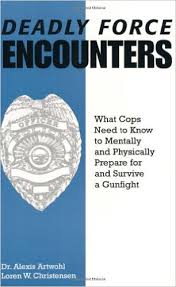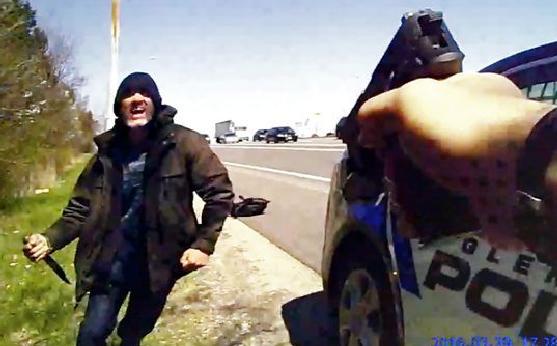
Deadly Force Encounters
May 23, 2017
“Bushidō is in being crazy to die. Fifty or more could not kill one such a man”. Nabeshima Naoshige
Preparing for violence is one of those “Catch-22” situations.
You’re trying to learn how to avoid violence, but have little experience.
But you don’t really want to go out and get experience, right? So you have to find a workaround, something that is proven to be useful.
I looked into how cops prepare. These are people, especially in certain specialties and locations, who can be reasonably certain of experiencing the real thing. How do they prepare?
In Deadly Force Encounters: What Cops Need To Know To Mentally And Physically Prepare For And Survive A Gunfight , Dr. Alexis Artwohl (behavioral science consultant to law enforcement ) and Loren W. Christensen (Vietnam vet, ex-cop, and Eastern martial artist) detail their recommendations for police who wish to prepare intelligently for extreme violence.
Unsurprisingly, the big problem is dealing with fear. The surprising thing is its mostly the physiological effects that are out of your control, aka what your nervous system does in your body when it perceives a life threatening situation.
Its a weird area, because you have to start talking about the brain as two different entities. There’s “you,” the conscious actor, and then there is the rest of your brain, the unconscious process, doing its own thing in the background. But these unconscious automatic parts of your brain are “intelligent” too. This part of the brain is watching and listening to the same sights and sounds “you” see and hear. The information coming in through your senses follows two paths. The faster path runs through your amygdala and other ancient parts of your brain. This part of your brain will evaluate the information based on very old assessments going back to the African plains.
Is it a snake or a spider – JUMP!!!!
This part of the brain is jumpy and paranoid and when it gets startled, it will cause many effects in your body. This is the challenge of a modern person in a dangerous situation. You need to use your higher brain and keep yourself under control while affected by the intense physiological symptoms of fear. Or, more precisely, what they call a state of arousal of the sympathetic nervous system.
The Autonomic Nervous System is made up of two parts, the parasympathetic (which controls low arousal states) and the sympathetic (which controls high arousal states).
I first heard about this stuff in Lt. Col. Dave Grossman’s books . While the information is slowly being processed by the prefrontal cortex (basically the conscious “you”), your body is already responding according to ancient scripts.
“When you perceive a threat, the sympathetic part of your ANS will kick in and your body will start to experience a high arousal state.” Some people enjoy this feeling. This is the rush from jumping out of a plane.
When we are in fear of our lives, a whole host of sensations and physical responses might occur. These are the effects that cops have to control when in a gunfight or dealing with a knife wielding assailant, as in the video clip below. They are trying to calmly deal with the threat, while they have a pounding heart, trembling, rapid, shallow breathing, dizziness, nausea, sweating, dry mouth, tingling in limbs, the urge to urinate or defecate. Tunnel vision, auditory exclusion, time distortion, dissociation. Automatic behavior.
Automatic behavior is what they call it when after the fact you say, “it just happened.” My gun appeared in my hand and he was dead. My hand hurt and he was laid out on the floor in front of me.
How do we prepare for all of this? It helps if you anticipate it will happen..
A “deadly force encounter” for a civilian will almost always happen unexpectedly and will involve people who are probably irrational and volatile
The only way to prepare is to rehearse. You really can only rehearse by using your imagination. This is where Stress Inoculation Training comes in.
In Deadly Force Encounters , Artwohl and Christensen break Stress Inoculation Training into three parts, the first of which is the most important: conceptualization of the stressor.
You have to run through scenarios in your head and rehearse what you would do. I suspect this is the reason for Walking Dead’s huge popularity. The news makes people anxious. So many of us are instinctively drawn to entertainment which helps us visualize dangerous scenarios. What would i do if…?
So the best thing you can do is accept the reality and likelihood of fear and stress responses in these situations.
Expect it will happen. You may freeze. You may piss yourself. Whatever.
Practice controlled breathing. Practice visualization.
In this clip below, the poor cop does not want to shoot this guy, but the man seems suicidally determined to force the cop to shoot. This is so common they call it “suicide by cop.” Note the cop wisely keeps this guy at the 21 foot foot limit .
To be prepeared, the situation cannot be a complete and total shock, so you have to regularly imagine a violent situation kicking off. Wherever you happen to be with a few minutes on your hands. In line at the grocery store or the mall.
Check out the HBO documentary Terror at the Mall , about an incident in Kenya where a group of gunmen (Islamic extremists) went on a killing spree at a modern mall (it looked just like the one near where I live). People where running in every direction as these men shot automatic weapons into the crowds.
What would you do in such a situation? I don’t want to take anything away from the bravery of the people who were in that situation. Fear will override your brain. But I saw many opportunities for people to take action. Some off-duty police did just that. Of course, some of them got shot.
The imagination is more powerful than we realize. You always hear about how star athletes use visualization to imagine doing the perfect thing. This is the same.
Your walk through in your imagination should take as long as it would take in reality. Add specific details, like you were writing a story about it. Your mind doesn’t really know the difference between your imaginings and reality; this is why you can be “scared” by a movie.
Imagine gunfire –ducking for cover. Think it through. Get behind something substantial, like an engine block. See 44 Minutes if you want to know what automatic weapons can do.
Imagine more likely scenarios such as a street incident with a belligerent drunk. What would you do if some big drunk got in your face and started yelling at you? What would you do if they took a swing?
The more times you play movies like this in your head, the more likely you are to act as you did in your mind. We fight like we train and these visualizations are part of training.

